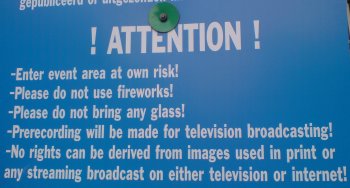Dam disclaimer for New Year’s concert

I know they have surveillance cameras and some web cameras downtown Amsterdam, but walking down the street and seeing a disclaimer posted before arriving on Dam Square made me uneasy. No glass and no fireworks is understandible, but warning me about possibly being on TV, YouTube and the likes does not seem necessary. Will people actually think of sueing for being on TV without their permission? I can’t possibly imagine it has come to this in 2008. And I’ll leave the quality of the English translation alone since it’s clear enough.

On the question of whether people might try to sue:
Of course, you have crazy people who think they have special rights not to be photographed in public places.
They don’t, of course, and a photo taken on the Dam on New Year’s Eve can be published in a newspaper or on a blog _ not even the House of Orange can prevent that, though they try to now and again.
But there is a question about using such photos for promotional or advertising purposes.
What happens if the city of Amsterdam takes a photo of _ for instance _ a couple kissing on the Dam on New Year’s Eve and then uses it for _ for instance _ an IAMsterdam promotion on all their official brochures?
Usually people have to sign a consent form waiving their rights before the city would be allowed, or else the people could say they were being used as models but not paid as models.
This is not special to growing copyright madness in 2008…
http://www.asmp.org/commerce/legal/releases/
I underdstand what you are saying, but we are in the Netherlands and you’re quoting an American site.
You can ‘what if’ all you like, so could I. And why have I never seen these disclaimers before on Dam Square? Maybe they just started in 2008.
Arnoud Engelfriet has published an analysis of “portrait rights.” His conclusion: you’re allowed to publish any picture of anybody, unless the publication is somehow damaging to that person. The examples he gives are of a woman photographed at a wild party, the use of portraits in commercials and so. Fame appears to work both ways; on the hand a famous person is “in the public eye,” and can therefore not lay a strong claim to privacy; but on the other hand their portrait is worth more, and therefore publication of it will sooner be deemed to damage their commercial interests.